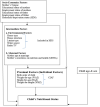Does Mothers' Awareness of Health and Nutrition Matter? A Case Study of Child Malnutrition in Marginalized Rural Community of Punjab, Pakistan
- PMID: 35211439
- PMCID: PMC8863129
- DOI: 10.3389/fpubh.2022.792164
Does Mothers' Awareness of Health and Nutrition Matter? A Case Study of Child Malnutrition in Marginalized Rural Community of Punjab, Pakistan
Abstract
Maternal nutritional awareness might reduce the risk of malnutrition in children. This study assesses the impact of mothers' nutritional and health awareness (MNHA) on the nutritional status of pre-school children in rural South Punjab. Using a proportionate purposive simple random sampling technique we collect data with the help of a self-administered questionnaire on height, age, the weight of children, and socio-economic profile from 384 rural households in one of the marginalized districts of Punjab. The study applied the binary logistic regression model to compute the probability of malnutrition. The results indicate that malnutrition was high in the district (the prevalence rate for underweight is 46.1%, for stunting 34.83%, and for wasting is 15.49%). Around 91.84% of malnourished children belonged to the low MNHA category compared to medium (5.61%) and high (2.55%) MNHA categories. The results further show that the prevalence of moderate and severe stunting, wasting, and underweight in low MNHA categories was much higher with large differences compared to both medium and high MNHA categories. The binary logistic regression results depict that, across the household deprivation index (HDS), the odds of a child becoming malnourished were lower in households HDS-2 category (OR = 0.02, 95% CI: 0.01-0.89), and odds were also lower in households HDS-3 category (OR = 0.001, 95% CI: 0.001-0.16). Similarly, across the scores of MNHA index, the odds of malnutrition were lower among the children of those mothers who had medium MNHA (OR = 0.04, 95% CI: 0.002-1.24), and also the probability of child malnutrition was lower among the children of mothers who had high MNHA (OR = 0.008, 95% CI: 0.002-0.29). The study urges that well-resourced, targeted, and coordinated health and nutritional education and awareness programs are required to tackle malnutrition.
Keywords: Pakistan; health and nutritional awareness; household deprivation; malnutrition; odds ratio.
Copyright © 2022 Shahid, Cao, Ahmed, Raza, Guo, Malik, Rauf, Qureshi, Saheed and Maryam.
Conflict of interest statement
The authors declare that the research was conducted in the absence of any commercial or financial relationships that could be construed as a potential conflict of interest.
Figures
Similar articles
-
Prevalence of child malnutrition and household socioeconomic deprivation: A case study of marginalized district in Punjab, Pakistan.PLoS One. 2022 Mar 10;17(3):e0263470. doi: 10.1371/journal.pone.0263470. eCollection 2022. PLoS One. 2022. PMID: 35271578 Free PMC article.
-
Determinants of stunting, underweight and wasting among children < 5 years of age: evidence from 2012-2013 Pakistan demographic and health survey.BMC Public Health. 2019 Apr 1;19(1):358. doi: 10.1186/s12889-019-6688-2. BMC Public Health. 2019. PMID: 30935382 Free PMC article.
-
Distance to Healthcare Facility and Lady Health Workers' Visits Reduce Malnutrition in under Five Children: A Case Study of a Disadvantaged Rural District in Pakistan.Int J Environ Res Public Health. 2022 Jul 5;19(13):8200. doi: 10.3390/ijerph19138200. Int J Environ Res Public Health. 2022. PMID: 35805858 Free PMC article.
-
Major factors responsible for child malnutrition: A review.J Pak Med Assoc. 2021 Feb;71(2(B)):729-733. doi: 10.47391/JPMA.1243. J Pak Med Assoc. 2021. PMID: 33941968 Review.
-
Prevalence of Malnutrition in Children with Congenital Heart Disease: A Systematic Review and Meta-Analysis.J Pediatr. 2022 Mar;242:39-47.e4. doi: 10.1016/j.jpeds.2021.10.065. Epub 2021 Nov 3. J Pediatr. 2022. PMID: 34742752
Cited by
-
Association among Household Wealth, Maternal Employment, and Undernutrition in Children under Three Years of Age in Pakistan.Children (Basel). 2024 Jul 18;11(7):872. doi: 10.3390/children11070872. Children (Basel). 2024. PMID: 39062321 Free PMC article.
-
Political Economy of Maternal Child Malnutrition: Experiences about Water, Food, and Nutrition Policies in Pakistan.Nutrients. 2024 Aug 10;16(16):2642. doi: 10.3390/nu16162642. Nutrients. 2024. PMID: 39203779 Free PMC article.
-
Determinants of Infant Young Child Feeding Among Mothers of Malnourished Children in South Punjab, Pakistan: A Qualitative Study.Front Public Health. 2022 May 19;10:834089. doi: 10.3389/fpubh.2022.834089. eCollection 2022. Front Public Health. 2022. PMID: 35664102 Free PMC article.
-
Effectiveness of nutritional awareness in child diet among mothers of under five in anganwadi in Mysuru: A quasi-experimental study.J Family Med Prim Care. 2024 Jan;13(1):254-258. doi: 10.4103/jfmpc.jfmpc_1161_23. Epub 2024 Feb 8. J Family Med Prim Care. 2024. PMID: 38482289 Free PMC article.
-
Sociodemographic factors associated with concurrent stunting and wasting among children experiencing extreme poverty in the Philippines: A cross-sectional study.Nutr Health. 2025 Jun;31(2):585-596. doi: 10.1177/02601060231203422. Epub 2023 Sep 27. Nutr Health. 2025. PMID: 37753712 Free PMC article.
References
-
- Khattak MK, Ali S. Malnutrition and associated risk factors in pre-school children (2-5 years) in District Swabi (NWFP)-Pakistan. Pak J Med Sci. (2010) 10:34–9. 10.3923/jms.2010.34.39 - DOI
-
- Ali W, Ayub A, Hussain H. Prevalence and associated risk factors of under nutrition among children aged 6 to 59 months in internally displaced persons of Jalozai Camp, District Nowshera, Khyber Pakhtunkhwa. J Ayub Med Coll Abbottabad. (2015) 27:556–9. Available online at: https://pubmed.ncbi.nlm.nih.gov/26721006/ - PubMed
-
- Batool SA, Shaheen AN, Rehman RA, Qamar S, Ahsan Raza SM, Jabeen R, et al. . To assess the nutritional status of primary school children in an Urban school of Faisalabad. Pak J Med Health Sci A. (2012) 6:776–9. Available online at: https://www.pjmhsonline.com/2012/july_sep/pdf/776%20%20%20To%20Assess%20...
-
- Babar NF, Muzaffar R, Khan MA, Imdad S. Impact of socioeconomic factors on nutritional status in primary school children. J Ayub Med Coll Abbottabad. (2010) 22:15–8. Available online at: https://ayubmed.edu.pk/JAMC/PAST/22-4/Nabeela.pdf - PubMed
MeSH terms
LinkOut - more resources
Full Text Sources
Medical


